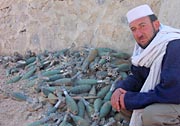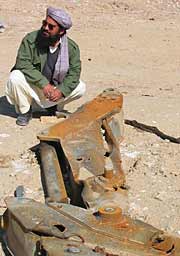|
On Deadly Ground
U.N. Team Inspects Taliban Base Now Littered With Bombs
 Listen to Steve Inskeep's report from Kandahar. Listen to Steve Inskeep's report from Kandahar.
 View a photo gallery of the bomb-strewn military base ruins. View a photo gallery of the bomb-strewn military base ruins.

|
|
Esmatullah, a paramedic with the U.N. bomb assessment team, poses in front of a cache of mortar shells scattered by a hit from a U.S. bomb.
Photo: Steve Inskeep, NPR
 View the photo gallery. View the photo gallery.
|
Jan. 28, 2002 -- The United Nations has begun what is expected to be a long effort to clear Afghanistan of unexploded bombs. The U.S. military dropped thousands of weapons in recent months -- and those that didn't detonate now rest among the untold tons of explosives left over from 23 years of war.
For All Things Considered, NPR's Steve Inskeep followed along as a U.N. team examined the damage in Kandahar, once the spiritual home of the Taliban. He discovers an area near the city awash with bomb fragments -- so many that the ground literally jingles when walked on.
A military compound called Gishla Jadid that once housed 12,000 soldiers is now a graveyard of twisted scrap metal and gravel. The scrap was once tanks, the gravel once barracks. The U.N. team has to move carefully because mortar shells, rockets and land mines are scattered everywhere. When U.S. bombs hit the weapon stockpiles, the explosions blasted munitions all over the site.
Nothing remains of the Taliban defenders -- except the burnt black soles of their shoes.

|
|
Noor Ahmad Azimy, the U.N. assessment team supervisor, inspects fragments of de-mining equipment destroyed by U.S. bombing.
Photo: Steve Inskeep, NPR
|
Noor Ahmad Azimy, the U.N. assessment team supervisor in Kandahar, warns that the base still has mines left over from when the Soviet Union fought for control of Afghanistan, two decades ago.
Cleaning the base will be a complicated job, Azimy says, and may take months. The base is one of at least 20 sites in Kandahar that the U.N. team is studying.
Outside the military base, in the middle of a farm field, the assessment team inspects an American Mark 84 bomb. It weighs 2,000 pounds and appears intact -- except for a few pieces missing from the outside.
The team later meets up with Mohammed Zai, who took the bomb parts -- some loading hooks and a small parachute. Zai makes his living as a scavenger. Sometimes he collects firewood to sell. Sometimes he takes apart bombs, and gets one American dollar for every two pounds of scrap aluminum.
The recent conflict has been good for his business, he says.
 Browse more NPR stories on Kandahar, the Taliban and land mines. Browse more NPR stories on Kandahar, the Taliban and land mines.
In Depth
 Steve Inskeep's report on the mosque of Mullah Omar, Jan. 23, 2002. Steve Inskeep's report on the mosque of Mullah Omar, Jan. 23, 2002.
 Steve Inskeep's report on Kandahar's "Cloak of the Prophet," Jan. 10, 2002. Steve Inskeep's report on Kandahar's "Cloak of the Prophet," Jan. 10, 2002.
 Steve Inskeep's photos of war-ravaged Afghanistan, Dec. 10, 2001. Steve Inskeep's photos of war-ravaged Afghanistan, Dec. 10, 2001.
 Pictures and audio from Afghanistan by NPR correspondent Eric Weiner, Dec. 28, 2001. Pictures and audio from Afghanistan by NPR correspondent Eric Weiner, Dec. 28, 2001.
Other Resources
• United Nations Development Programme: Mine Clearing
• Lonely Planet Guide: Afghanistan
• Afghan-Info.com
|